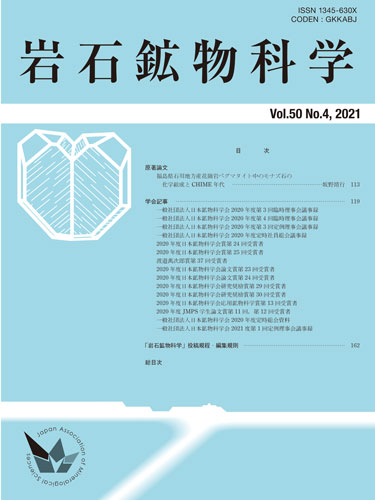Volume 52, Issue 1
Displaying 1-13 of 13 articles from this issue
- |<
- <
- 1
- >
- >|
Key Points for Technical Skills in Analyzing Minerals and Experimental Works
-
2023 Volume 52 Issue 1 Article ID: 230725
Published: 2023
Released on J-STAGE: December 06, 2023
Advance online publication: November 21, 2023Download PDF (4176K)
New Minerals and Occurrences in Japan
-
2023 Volume 52 Issue 1 Article ID: 231004
Published: 2023
Released on J-STAGE: October 31, 2023
Advance online publication: October 20, 2023Download PDF (1541K)
Recent Advances
-
2023 Volume 52 Issue 1 Article ID: 230724
Published: 2023
Released on J-STAGE: September 26, 2023
Advance online publication: September 07, 2023Download PDF (2310K)
Short Review & Scientific Communication
-
2023 Volume 52 Issue 1 Article ID: 230208
Published: 2023
Released on J-STAGE: September 08, 2023
Advance online publication: August 09, 2023Download PDF (561K)
Short note
-
2023 Volume 52 Issue 1 Article ID: 230516
Published: 2023
Released on J-STAGE: August 30, 2023
Advance online publication: August 08, 2023Download PDF (976K)
Short Review & Scientific Communication
-
2023 Volume 52 Issue 1 Article ID: 221029
Published: 2023
Released on J-STAGE: August 03, 2023
Advance online publication: July 14, 2023Download PDF (11156K)
2021 Award winners and their studies
Japan Association of Mineralogical Sciences Award, No. 26
-
2023 Volume 52 Issue 1 Article ID: 230203
Published: 2023
Released on J-STAGE: July 28, 2023
Advance online publication: June 28, 2023Download PDF (7348K)
Short Review & Scientific Communication
-
2023 Volume 52 Issue 1 Article ID: 230302
Published: 2023
Released on J-STAGE: June 29, 2023
Advance online publication: May 19, 2023Download PDF (2481K)
2021 Award winners and their studies
Japan Association of Mineralogical Sciences Award for Young Scientists, No. 32
-
2023 Volume 52 Issue 1 Article ID: 230204
Published: 2023
Released on J-STAGE: June 17, 2023
Advance online publication: May 31, 2023Download PDF (2605K)
2021 Award winners and their studies
Japan Association of Mineralogical Sciences Award for Applied Mineralogy, No. 14
-
2023 Volume 52 Issue 1 Article ID: 230110b
Published: 2023
Released on J-STAGE: June 16, 2023
Advance online publication: May 26, 2023Download PDF (3559K)
Guide for Museums in Japan
-
2023 Volume 52 Issue 1 Article ID: 230127
Published: 2023
Released on J-STAGE: May 13, 2023
Advance online publication: April 08, 2023Download PDF (3762K)
2021 Award winners and their studies
Japan Association of Mineralogical Sciences Award for Young Scientists, No. 31
-
2023 Volume 52 Issue 1 Article ID: 230110a
Published: 2023
Released on J-STAGE: May 09, 2023
Advance online publication: April 13, 2023Download PDF (6189K)
Review
-
2023 Volume 52 Issue 1 Article ID: 221005
Published: 2023
Released on J-STAGE: January 31, 2023
Download PDF (1060K)
- |<
- <
- 1
- >
- >|
